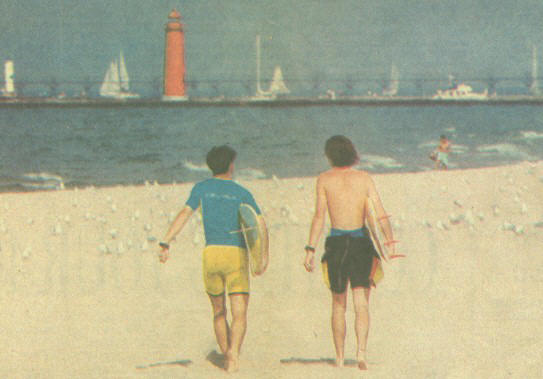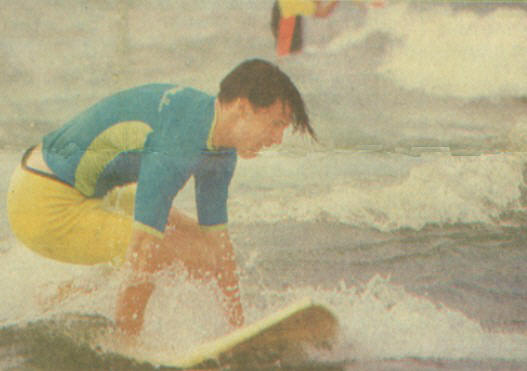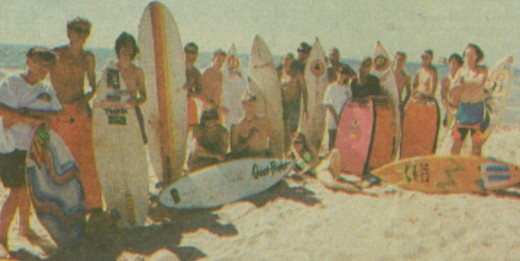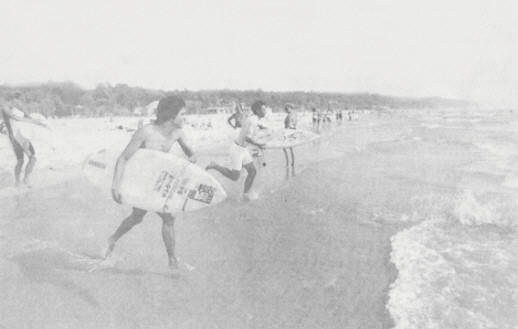
GEORGE GRYZENIA/Special to the Free Press.
Go west, young surfer, but not necessarily as far as California. Northville High School student Bryan Russell, left, and Dave Barney of Dearborn like to surf in west Michigan.
Detroit Free Press September 10, 1991

GEORGE GRYZENIA/Special to the Free Press.
Go west, young
surfer, but not necessarily as far as California. Northville High School
student Bryan Russell, left, and Dave Barney of Dearborn like to surf in west
Michigan.
RIDE THE MILD SURF
Michigan surf diehards say the Great
Lakes are not a complete washout
By Neely Tucker
Knight-Ridder Newspapers
SURF CITY, Michigan (GRAND HAVEN) — Dave “The Wave” Irwin won the 25th Anniversary Great Lakes Surfing Association Tournament, catching radical tube rides on clean, glassy, double-overhead waves, a mastery of surging Lake Michigan that left thousands of spectators dazzled and a national ESPN audience enthralled.
“It was terrifying. It made the {Hawaii) Pipeline look like a kiddie pool,” said Irwin, a lanky, bleached-blond surf rat, from his spot in a bevy of young women in thong swimsuits.
Well ... Ummm … sort of.
See, David Irwin, a 30-year Chrysler insurance executive from Bloomfield Hills, Mich., with neatly moussed, thinning black hair and a little extra insulation around the belly, really did win the tournament last weekend. And he insists he would have mastered those monster sets. If only there’d been any.
Ditto for the babes.
Instead, the waves were 1- to 2-foot mush. “Smurf,” in surfer lingo.

Barney takes on the subdued waves — nicknames smurf — of Lake Michigan.
And the contest, which drew about 20 surfers from Michigan and Illinois, took place on largely deserted Grand Haven City Beach.
The weather-becalmed weekend was a nasty setback because Great Lakes surfers are forever fighting for recognition of their existence, much less respect. And in 1991, three decades after Robert "Aquadoc" Beaton fist caught a Lake Michigan wave, the 40 or 50 active surfers in the Midwest are attempting to establish a bona fide surf culture.
Tournament organizer Pat Shooltz of Eaton Rapids, Irwin, Paul Kevelin of Birmingham, John Peters of Bloomfield Hills — all professionals in their late 20s or early 30s — are organizing a surfing network across the Great Lakes. Saturday, as ankle-slapping waves pounded the beach and sent toddlers sprawling, they also laid out plans for a newsletter, a hotline and six tournaments a year.
“Wowwww,” says Mr. Kevelin.
Those plans would get a laugh in California. But Great Lakes — a shivering, desperate crowd — are undaunted by skepticism and biting cold. Surf culture rolled into Grand Haven, a small beach resort west of Grand Rapids, in the mid-1960s.
Great Lakes Surfing, by all accounts, got a fledging start when World War II veterans came back from Hawaii, lugging boards they'd seen surfers riding there. But in 1961, 14-year-old Robert Beaton finally got things rolling.
“The first ‘surfboard’ I had was actually a 13-foot sailboat with the mast, rudder and centerboard pulled out,” he says. You had to have three guys to surf:: Two of us pushed it out past the break. One would ride it back in, and the other guy would tread water and wait. Then, the surfer and the other guy would push it back out, another guy would hop on, while another guy swam back in with him.”
It didn’t get much better the next summer. A friend’s dad ran a boat factory and had his workers make a surfboard for the kids. Problem was, the guy built it just like a boat.
“It was about 9 feet long, flat on the top and was hollow inside with reinforced ribs,: Mr. Beaton remembers. “And the guy couldn’t round off the end very well. It wound up looking like a coffin. It sank like a rock.”
Finally, in 1964, a local boat shop stocked a few surfboards. It coincided with the suddenly popular Beach Boys romantic surf songs.
“It was like a mini-California,” Mr. Beaton says of the Grand Haven beach scene. “When the surf wasn’t up, which was often, guys carved tiki dolls, or made skateboards from roller skates, or went sand surfing — you cut a ski board in half, then ride it down a sand dune. We were after anything that felt like surfing.”
By the time the surfing flick "Endless Summer" came out in 1966, Mr. Beaton was firmly hooked.
“I took my girlfriend to see that movie three times a day six days in a row at the old RKO Regent theater. We had headaches every day after coming out. But she hung in there. We went to every show. Best girlfriend I ever had.”
Beaton and friends also went on safaris to Mexico or California — a move that didn’t sit well with the California natives.
The sudden overcrowding of good surf spots made the locals downright mean. Midwesterners were generally dubbed “lurkers,” “barnies,” “gremmies,” or worst, “kooks.” Nobody at Zuma Beach was buying into the possibility of surfing in a lake, no matter how big the lake might be.
That was snobbery, but it was largely true.

Members of the Great Lakes Surfing Association: A hale and hearty breed.
Surfing everywhere is driven by storm systems. Coastal surfers ride waves that are the result of wind and waves building over thousands of miles of ocean. But the Great Lakes are only a few hundred miles wide. This makes heavy surf less frequent. Waves are also slower, less buoyant (because of the lack of saltwater) and much less powerful.
This means surfers have to use bigger, less maneuverable boards to stay afloat.
Worse, waves do not come in clean sets, like they do the ocean. They just pound in one after another. In the lakes, submerged rocks, or long piers have to shape the waves. In Grand Haven, the best surf spot is right along the pier. Surfers just walk out on the pier, jump in and ride waves to the beach.
Coastal surfers wouldn’t be caught dead doing that.
Beaton shrugs. “Sometimes, it’s the only way you can get out,” he says. “In the winter, you can only last a half an hour. Why waste it trying to paddle through the break?”
Aaah, yes. Winter. Lovely surfing season. When waves are finally powerful and water temperatures are c-c-cold enough to make surfers wear two wetsuits, boots and a hood.
Bob Pushaw became a celebrity of sorts when a local news camera crew filmed him surfing 10-foot sets off Grand Haven. There was ice on the lake. Icicles hung from the nearby pier. Two feet of snow covered the beach.
“I drove over to the lake that day in a complete whiteout,” he says. "it was snowing like hell.
“It’s pretty radical. I tell folks: ‘Leave the drugs at home. Surf Lake Michigan at night in November. It’s all the sensation you could ever want.’”
Such conditions quickly weeded surfers from the sane, and surfing popularity here waned in the 1970s and ‘80s. The Surfing Association peaked at 300 members. Most rode boogie boards — a sort of surfboard with training wheels — or were guys from Pennsylvania who dropped in once or twice. The organization fell apart years ago.
Saturday's tournament was an attempt to get the sport going again. But sunny, breezy, 85-degree weather settled over western Michigan. Good surfers like Pushaw and Beaton didn’t bother going. Most of the 17 people signed up to compete were raw beginners. Others were teen-agers with only one short board — about 6 feet long. Those are fine for big waves, but they just sink on slow days like this. Irwin won largely because he had the largest, most buoyant board.
“Nobody’s mistaking this for the North Shore,” he grinned sheepishly.

GEORGE GRYZENIA/Special to the Free Press.
Surf's up for Bob Vanderweele of Portage, Mich., and other Great Lakes surfers.
As the day wound down, the group also collected annual dues ($10). They told everyone that the group has the support of Surfing Magazine, and that they hope to connect with dozens of surfers through the Midwest.
They're counting on enthusiasm of young kids and transplants from the coasts to make it work.
"I start in June and go until the lake freezes over," says 17-year-old Bob Vanderweele of Portage, Mich. "I'm not a real pro. I just go to the beach whenever it's windy.
Dave Barney, 17, who moved from San Clemente to Dearborn last year, tries to recruit friends to go surfing.
“They think I’m kidding,” he says. “Nobody believes you can surf up here.”
They’ll try again, during the first weekend in October, when another surfing tournament is scheduled here.
Meanwhile, smurf’s up!
Great Lakes surfers also occasionally catch waves around St. Joseph, Muskegon, Charlevoix. For more information, call the Great Lakes Surfing Association at 334-3147 anytime. Or write: P.O. Box 7281, Bloomfield Hills, Mich., 48302-7281.